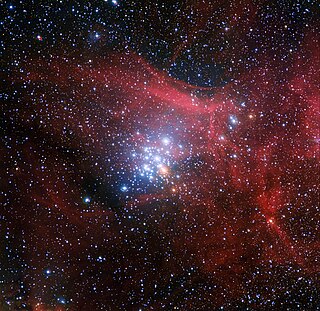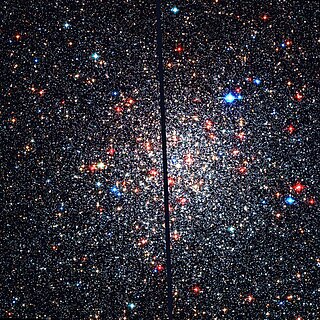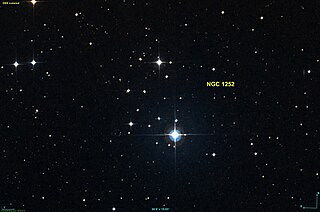
A planetary nebula is a type of emission nebula consisting of an expanding, glowing shell of ionized gas ejected from red giant stars late in their lives.

Messier 73 is an asterism of four stars in the constellation Aquarius which was long thought to be a small open cluster. It lies several arcminutes east of globular cluster M72. According to Gaia EDR3, the stars are 1030±9, 1249±10, 2170±22, and 2290±24 light-years from the Sun, with the second being a binary star.

NGC 225 is an open cluster in the constellation Cassiopeia. It is located roughly 2,200 light-years from Earth. It is about 100 to 150 million years old.

NGC 2547 is a southern open cluster in Vela, discovered by Nicolas Louis de Lacaille in 1751 from South Africa. The star cluster is young with an age of 20-30 million years.

NGC 4463 is an open cluster in the constellation Musca. The young planetary nebula He 2-86 is believed to be a member of the cluster.

NGC 3293 is an open cluster in the Carina constellation. It was discovered by Nicolas-Louis de Lacaille in 1751. It consists of more than 100 stars brighter than 14th magnitude in a 10 arc minute field, the brightest of which are blue supergiants of apparent magnitude 6.5 and 6.7. There is also a 7th magnitude pulsating red supergiant, V361 Carinae.

The Mars trojans are a group of trojan objects that share the orbit of the planet Mars around the Sun. They can be found around the two Lagrangian points 60° ahead of and behind Mars. The origin of the Mars trojans is not well understood. One theory suggests that they were primordial objects left over from the formation of Mars that were captured in its Lagrangian points as the Solar System was forming. However, spectral studies of the Mars trojans indicate this may not be the case. Another explanation involves asteroids chaotically wandering into the Mars Lagrangian points later in the Solar System's formation. This is also questionable considering the short dynamical lifetimes of these objects. The spectra of Eureka and two other Mars trojans indicates an olivine-rich composition. Since olivine-rich objects are rare in the asteroid belt it has been suggested that some of the Mars trojans are captured debris from a large orbit-altering impact on Mars when it encountered a planetary embryo.

Terzan 5 is a heavily obscured globular cluster belonging to the bulge of the Milky Way galaxy. It was one of six globulars discovered by French astronomer Agop Terzan in 1968 and was initially labeled Terzan 11. The cluster was cataloged by the Two-Micron Sky Survey as IRC–20385. It is situated in the Sagittarius constellation in the direction of the Milky Way's center. Terzan 5 probably follows an unknown complicated orbit around the center of the galaxy, but currently it is moving towards the Sun with a speed of around 90 km/s.

Cygnus OB2 is an OB association that is home to some of the most massive and most luminous stars known, including suspected Luminous blue variable Cyg OB2 #12. It also includes one of the largest known stars, NML Cygni. The region is embedded within a wider one of star formation known as Cygnus X, which is one of the most luminous objects in the sky at radio wavelengths. The region is approximately 1,570 parsecs from Earth in the constellation of Cygnus.

NGC 2467, nicknamed the "Skull and Crossbones Nebula", is a star-forming region whose appearance has occasionally also been likened to that of a colorful mandrill. It includes areas where large clouds of hydrogen gas incubate new stars. This region was one of the areas featured in the book Hubble's Universe: Greatest Discoveries and Latest Images by Terence Dickinson.

NGC 654 is an open cluster in the constellation Cassiopeia. It was discovered by William Herschel in 1787. With apparent magnitude 6.5, it can be observed by binoculars. It is located 2,5° northeast of the star Delta Cassiopeiae. In the same low power field can also be seen the open clusters NGC 663 and NGC 659. It surrounds a 7th magnitude yellowish star, an F5Ia supergiant, which is a possible member of the group.

WR 21a is an eclipsing binary star in the constellation Carina. It includes one of the most massive known stars and is one of the most massive binaries.

NGC 1901 is an open cluster in the Dorado Constellation. It has a bright middle and is a little rich, with stars from 7th magnitude downwards. The celestial object was discovered on 30 December 1836 by the British astronomer John Herschel. The cluster is sparsely populated with GAIA data suggesting a membership of around 80 stars. It is considered unlikely it will survive its next pass through the Milky Way’s galactic plane in about 18 million years time.

NGC 6553 is a globular cluster in the constellation Sagittarius. NGC 6553 has an apparent magnitude of about 8th magnitude with an apparent diameter of 8.2 arcminutes. Its Shapley–Sawyer Concentration Class is XI, meaning the star concentration is very loose even at the center; it has stars of magnitude 20 and dimmer. It is located just over a degree southeast of Messier 8, the Lagoon Nebula.

NGC 5617 is an open cluster in the constellation Centaurus. NGC 5617 forms a binary open cluster with Trumpler 22. It lies one degree west-northwest of Alpha Centauri.
NGC 6863 is an asterism in the constellation Aquila. The celestial object was found on July 25, 1827, by the British astronomer John Herschel.

NGC 1252 is a metal-poor, possible open cluster or open cluster remnant located in the constellation Horologium, containing around 20 stars. Discovered in 1834 by John Herschel, it was described by John Louis Emil Dreyer as an 8th-magnitude star surrounded by a group of 18 or 20 stars. Stars TW Horologii and HD 20286 were once considered to be part of NGC 1252, but this is now not likely.















